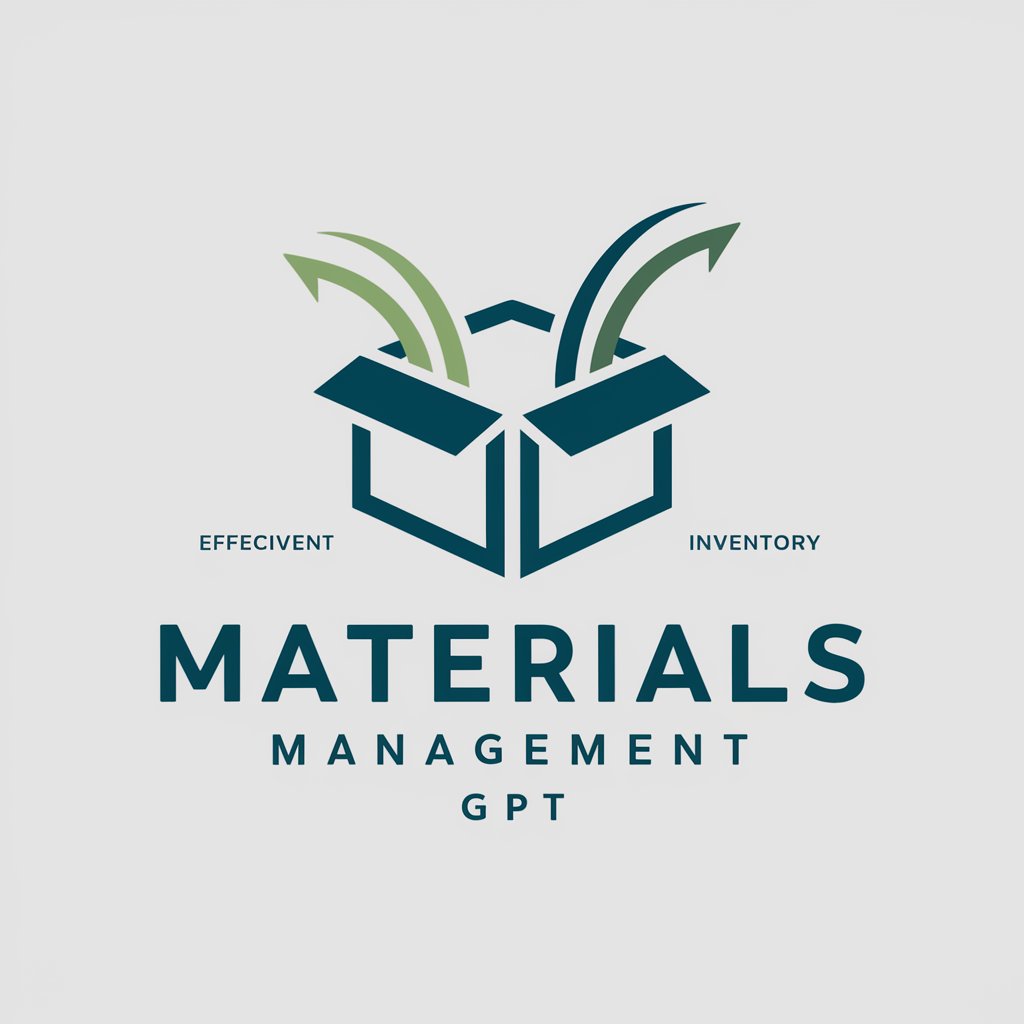Materials Management - Materials Management Aid

Welcome! Let's optimize your materials management for maximum efficiency.
Streamlining operations with AI-driven insights
Can you provide best practices for inventory management in a manufacturing setting?
What are effective strategies for optimizing supply chain operations?
How can we improve resource efficiency in our production process?
What are the key considerations for handling materials in a warehouse environment?
Get Embed Code
Introduction to Materials Management
Materials Management is a strategic approach focused on planning, sourcing, purchasing, moving, storing, and controlling materials in an optimum manner so as to provide a pre-decided service to the customer at a minimum cost. From raw material procurement to finished goods delivery, it encompasses all activities involved in the flow of materials to, through, and from an organization. An example of this in action is the supply chain of a manufacturing company where efficient materials management ensures that the right quantity of materials is available for production at the right time, minimizing storage costs and reducing lead times. Scenarios illustrating the purpose of materials management include optimizing inventory levels to reduce holding costs, implementing just-in-time (JIT) procurement strategies to minimize excess inventory, and enhancing supplier relationships to ensure the timely and cost-effective acquisition of quality materials. Powered by ChatGPT-4o。

Main Functions of Materials Management
Inventory Management
Example
Using automated inventory tracking systems to maintain optimal inventory levels.
Scenario
A retail company implements a real-time inventory management system to track stock levels, forecast demand, and automatically reorder products to prevent stockouts and overstocking.
Supply Chain Optimization
Example
Developing strategic partnerships with suppliers to improve material quality and delivery timelines.
Scenario
An automotive manufacturer collaborates with its suppliers to implement a synchronous manufacturing process, reducing material lead times and improving production efficiency.
Procurement and Sourcing Strategy
Example
Conducting supplier evaluations to select and negotiate with the best suppliers.
Scenario
A construction company conducts thorough market research to identify the most reliable suppliers for high-quality building materials, negotiating favorable terms to ensure cost savings and timely delivery.
Waste Reduction and Sustainability
Example
Implementing recycling programs and using materials more efficiently to minimize waste.
Scenario
A food processing plant adopts a zero-waste strategy, where organic waste is converted into compost for local farms, and packaging materials are selected for their recyclability, reducing environmental impact and costs.
Ideal Users of Materials Management Services
Manufacturing Companies
These businesses require efficient management of raw materials, work-in-progress inventory, and finished goods to minimize costs and maximize productivity. Materials Management helps in optimizing the production process, ensuring timely availability of materials, and reducing excess inventory and associated costs.
Retail and E-commerce Businesses
For these companies, effective materials management is crucial for managing inventory across different locations, ensuring product availability to meet consumer demand, and optimizing warehousing and distribution to reduce lead times and shipping costs.
Healthcare Organizations
Materials management in healthcare involves managing the supply of pharmaceuticals, medical devices, and other supplies. It is critical for maintaining high service levels, ensuring patient safety, and controlling operational costs through efficient inventory management and procurement practices.
Construction Firms
These firms benefit from materials management through efficient procurement and logistics planning, minimizing delays due to material shortages, optimizing the use of materials on-site to reduce waste, and ensuring project timelines and budgets are met.

How to Utilize Materials Management
Initiate Trial
Start by visiting yeschat.ai to access a free trial effortlessly, without the need for login or a ChatGPT Plus subscription.
Identify Needs
Assess your operational or business requirements to determine how materials management can best support your objectives, such as inventory optimization or supply chain efficiency.
Explore Features
Familiarize yourself with the tool's features, including inventory tracking, demand forecasting, and resource allocation, to fully leverage its capabilities.
Apply Best Practices
Implement industry best practices for materials management, such as Just-In-Time inventory, to minimize waste and reduce costs.
Monitor and Adjust
Regularly review performance metrics and feedback to refine your materials management strategy, ensuring continuous improvement in efficiency.
Try other advanced and practical GPTs
Hazardous Materials
Navigating HazMat with AI Precision

Global Heliogenesis University
Empowering sustainable construction with AI-driven insights.

Web Scraper Schema Assistant
Automate Structured Data Generation

AGI
Empowering Ethical Decisions with AI

Hack
Empowering Cybersecurity with AI

Moral Compass
Navigate ethical dilemmas with AI-powered insight.

Q - Discover Products
AI-powered product-service analysis

New Products SEO
Optimizing Products with AI Power

AI Assistant Negotiator Supply Chain
Optimize negotiations with AI power

Party Supply
Elevate Your Events with AI-Powered Party Planning

Expert Secondary Math Educator
Elevating Math Education with AI

math lesson
Empowering learning through AI-driven math lessons

Materials Management Q&A
What is the primary goal of Materials Management?
The primary goal is to ensure that the right materials are available in the right quantity, at the right time, and at the right place, to facilitate smooth and cost-efficient production and operations.
How can Materials Management reduce operational costs?
It reduces costs through efficient inventory control, minimizing excess stock and avoiding shortages, optimizing procurement practices, and streamlining the supply chain to reduce waste and inefficiencies.
What role does technology play in Materials Management?
Technology plays a crucial role by providing tools for inventory tracking, demand forecasting, supply chain visualization, and data analysis, enabling more informed and efficient decision-making.
Can Materials Management support sustainability efforts?
Yes, it supports sustainability by optimizing resource use, reducing waste, encouraging the use of eco-friendly materials, and ensuring efficient logistics to lower carbon footprints.
How does Materials Management handle unexpected disruptions in the supply chain?
It involves strategic planning, including maintaining safety stock, diversifying suppliers, and implementing robust demand forecasting to anticipate and mitigate the impact of disruptions.
